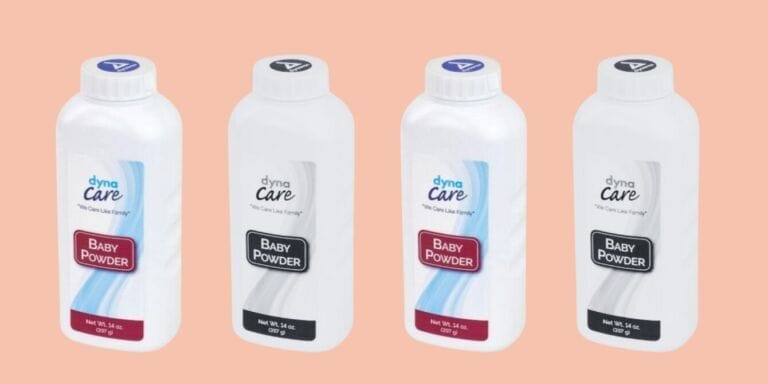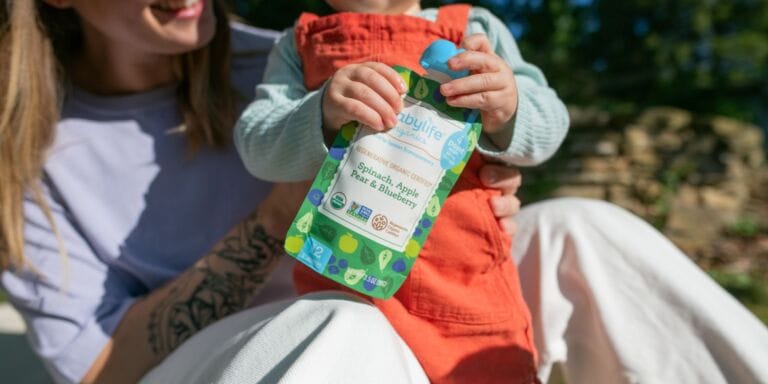Toxic heavy metals are *still* present in baby food: What you need to know

A new congressional report exposes the inaction of certain baby food companies.
Table of Contents
High levels of toxic heavy metals are still present in baby food being sold on store shelves, a congressional report released this week found. The new report comes after a previous report in February 2021 first released the findings, and highlights “the industry’s failure to end harmful practices that pose serious health risks to babies and toddlers.”
The report’s findings describe levels well beyond the FDA’s limit of arsenic, lead, cadmium and mercury in baby food. Over time, with regular exposure, these toxins can be particularly dangerous to developing babies and toddlers.
If you’re raging now, you’re not alone. The discovery is alarming, and proves that several companies named in the initial report (including Gerber, Beech-Nut, Happy Family Organics, Sprout Foods, Earth’s Best Organics and Plum Organics) didn’t go far enough to correct the issues of heavy metals in baby food the first time around.
Rep. Raja Krishnamoorthi, Chairman of the Subcommittee on Economic and Consumer Policy who led the investigation says, “My Subcommittee’s investigation has pulled back the curtain on the baby foods industry, and each revelation has been more damning than the last. Today’s report reveals that companies not only under-report the high levels of toxic content in their baby food, but also knowingly keep toxic products on the market. The facts speak for themselves, and the fact of the matter is that the baby food industry has consistently cut corners and put profit over the health of babies and children.”
The report found evidence of incomplete or nonexistent recalls
The primary takeaways from the Subcommittee’s report are listed below:
- Beech-Nut’s June 2021 baby food recall was incomplete. Investigators in the state of Alaska found multiple samples of both Beech-Nut’s and Gerber’s infant rice cereals contained levels of arsenic much higher than the FDA’s limit of 100 parts per billion (ppb), which is “an already dangerously-high standard that FDA is now lowering.” Beech-Nut also apparently only recalled two of its six products that originally tested over the limit.
- Gerber failed to recall any of its toxic products. According to the report, “Gerber was even worse—it had two products test over the 100 ppb limit and took no action to tell the public or get them off the shelves.”
- Plum Organics baby foods have levels of arsenic, lead and cadmium well over FDA-approved levels. “Plum Organic’s finished products contain up to 225 ppb inorganic arsenic. The majority of Plum’s baby foods also contain over 5 ppb lead, and nearly 40% exceed 5 ppb cadmium.”
- Walmart decided to weaken its arsenic standard. In 2018, Walmart quadrupled its maximum limit of arsenic to 100 ppb “without any justification.” This decision “was an extreme course reversal on efforts to protect babies’ neurological development.”
- The baby food industry still refuses to test its finished products for heavy metals, despite knowing its current ingredient testing method undercounts heavy metals. Sprout’s testing practices appear to be the weakest of the group, “as they allow their ingredient manufacturers to test only once a year and do not test their finished products.”
While low levels of heavy metals are likely only a small part of a child’s overall toxin exposure, heavy metal exposure can be harmful to the developing brain, says the American Academy of Pediatrics (AAP). “It’s been linked with problems with learning, cognition, and behavior.” Though genetic and social factors also play a role in brain development, “[heavy metal toxin] exposure from all sources should be minimized,” says the AAP.
How do heavy metals get into baby food?
Heavy metals abound in our natural environment as they’re formed in the earth’s crust, but they can also be released as a result of pollution. They can leach into baby food made from fruits and vegetables that have been grown in tainted water and soil, which can be hard to avoid without regular testing.
Metals can also get into food through manufacturing, processing and packaging processes, or when manufacturers add enzymes or vitamin and mineral blends to foods that may already be tainted. It’s important that baby food companies routinely test all ingredients before and after processing to determine where the toxins are coming from.
Why is this still happening?
Manufacturers’ actions after the initial congressional report didn’t go far enough, and it looks like federal regulation will be required in order to get manufacturers working to fully remedy the issues. “They haven’t so far shown either the capacity or the willingness to regulate themselves. You need a federal regulator in the form of FDA to be regulating them closely,” Rep. Krishnamoorthi says to CBS News.
In response to the initial congressional report released in February 2021, the FDA announced the Closer to Zero action plan in April, which aimed to outline “[the FDA’s] approach to reducing exposure to toxic elements in foods commonly eaten by babies and young children to the lowest possible levels.”
However, the FDA’s final guidance for new allowable federal levels are still under discussion until 2024. Those timelines “are far too slow,” state the Subcommittee in the report, and recommend accelerating the proposed timelines.
The FDA doesn’t want to rush the process. “We are also sensitive to the fact that requiring levels that are not currently feasible could result in significant reductions in the availability of nutritious, affordable foods that many families rely on for their children, the agency states. “It’s crucial that measures to limit toxic elements in foods do not have unintended consequences—like limiting access to foods that have significant nutritional benefits by making them unavailable or unaffordable for many families.
What should you do now?
If you’ve previously fed these foods to your little one, try not to panic.
“The issue is a chronic exposure issue, not an acute exposure issue,” Chief Scientific Officer for Consumer Reports, James H Dickerson, previously explained to Motherly. “Chronic exposure means long-term exposure over months and years of repeated exposure. Acute exposure means a single time, or five times or 10 times of exposure, consuming these foods would lead to a risk. That’s not the case at all.”
Making changes now by swapping out foods that are potential sources of heavy metals is your best bet in reducing your child’s exposure. Ultimately, serving a wide variety of fruits and vegetables daily can help avoid accidental contamination due to overexposure of the same few foods.
“Our recommendation is for balance, balance, balance,” says Dickerson. “What that means is that you should feed your children a balance of grains, a balance of fruits and vegetables, a balance of proteins.”
Here are other tips to keep in mind:
- Avoid any baby food products made with rice, including brown rice, rice milk, brown rice syrup or other rice products, as brown rice is a primary source of inorganic arsenic based on the way it’s grown.
- Avoid any baby cereals made with rice, opting for oats, barley or mixed grains instead.
- Avoid puffed rice snacks and teethers.
- Toss all store-bought baby food products currently in your pantry/fridge, specifically any sweet potato or carrot purees, all rice-based products and all fruit juices, which also may contain dangerously high levels of heavy metals. This is hard to do, but it’s the safest step until more regulations are put in place.
- Consider making your own baby food purees, and filling reusable containers or pouches for on-the-go use.
- Peel any root vegetables, like sweet potatoes, carrots and beets before cooking to remove potential contaminants on the surface.
- Aim to limit packaged baby foods in favor of homemade muffins and bars when possible.
- Advocate for change. Reach out to brands you love and your representatives to put pressure on manufacturers and government agencies to take stricter action and support the Baby Food Safety Act.
Be sure to talk to your child’s pediatrician and find more tips on reducing heavy metal exposure from the AAP here.





































